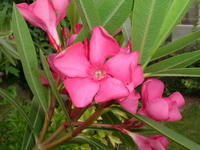White Oleander
 The plants that are the most fascinating when you're a kid are inevitably the ones your mother tells you are poisonous. You look on them with such fascination. Their jewel-like berries -- will they kill ants? They go into old soda bottles with water and leaves -- a poison elixer. But you did what your mom told you to do and never ate them. But oleander -- common along roadways and gardens in Southern California -- you stayed away from that one.
The plants that are the most fascinating when you're a kid are inevitably the ones your mother tells you are poisonous. You look on them with such fascination. Their jewel-like berries -- will they kill ants? They go into old soda bottles with water and leaves -- a poison elixer. But you did what your mom told you to do and never ate them. But oleander -- common along roadways and gardens in Southern California -- you stayed away from that one.Oleander is a plant with a storied history. Originally of Mediterranean origin (though it was found as far afield as China), it figures prominantly in both Greek and Judeo-Christian mythologies (making a notable appearance as the wood that was the staff of St. Joseph, husband to the Virgin Mary.) It came over to the New World as part of a movement by the Spaniards to turn the West Indies into a Paradise of old world plants and fruit trees.
Though there are a bunch of stories of hapless groups of people roasting hot dogs on or making fires of oleander wood and dying, (and in fact the wood and smoke are supposed to be poisonous) there are no actual records of such accidents. Children appear to be particularly susceptable to the poison because of their small size and proclivity to ingest inadvisable things. Pets and horses often perish after chewing oleander bark or leaves, which they find sweet. Apparently, the taste is bitter and nauseating, causing people to gag. As little as four ounces of leaves can kill an adult human. To date, only one person has ever been recorded to die from oleander poisoning -- his wife whipped up a concoction of oleander leaves and anti-freeze (you'd think the anti-freeze would have been enough!)

0 Comments:
Post a Comment
<< Home